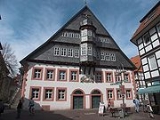
Osterode am Harz
Encyclopedia
For the town in East Prussia
formerly called Osterode, see Ostróda
.
Osterode am Harz often simply called Osterode, is a town in south-eastern Niedersachsen
on the south-western edge of the Harz
mountains. It is the seat of government of the district of Osterode
. The town is twinned with Scarborough, in the United Kingdom
. Osterode is located on the German Framework Road
.
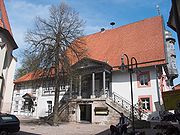
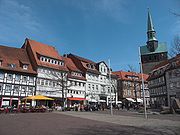


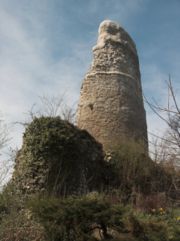
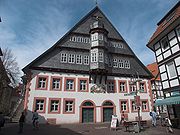
river flows through the town from the Sösetalsperre reservoir
lake about 5 km upstream. The dam was built in 1931 and has a capacity of 25.5 million m³. The Harzwasserwerke
water company pipes drinking water
as far away as Bremen
.
and one Bürgermeister (mayor).
(local election
on 10 September 2006)
, France
(one of the bridges over the Söse is called "Armentieres Bridge"). Ostróda
, Poland
, formerly had the same name "Osterode" and formerly in the German territory of Ostpreußen (in the of the town is a stone with the inscription: "Noch 826 Kilometer bis Osterode/ Ostpreußen" – "826 km to Osterode, East Prussia") Scarborough, England
to the recent past, as well as occasional temporary exhibitions.
ruins
, and
Lichtenstein Castle
between Dorste and Förste.
The town granary
built between 1719 and 1722 is one of the most imposing buildings, built to supply the mining villages in the Upper Harz
with grain. Today after a comprehensive renovation it has become the town hall.
, a hiking
trail to Thale
.
, is the main western link between the northern and southern Harz
area. B 241 and B 498 link Solling
to the eastern Harz.
Osterode lies on the Herzberg
–Seesen
railway, with services to Brunswick
. In November 2004 the city gained two new stations at a cost of about 1 million Euro
, replacing two previous halts and providing a more central access to public transport
.
East Prussia
East Prussia is the main part of the region of Prussia along the southeastern Baltic Coast from the 13th century to the end of World War II in May 1945. From 1772–1829 and 1878–1945, the Province of East Prussia was part of the German state of Prussia. The capital city was Königsberg.East Prussia...
formerly called Osterode, see Ostróda
Ostróda
Ostróda is a town in Ostróda County in the Warmian-Masurian Voivodeship in Poland, with 33,603 inhabitants as of January 1, 2005. It lies in the Masurian Lake District and is a growing tourist site owing to its relaxing natural surroundings.-History:...
.
Osterode am Harz often simply called Osterode, is a town in south-eastern Niedersachsen
Lower Saxony
Lower Saxony is a German state situated in north-western Germany and is second in area and fourth in population among the sixteen states of Germany...
on the south-western edge of the Harz
Harz
The Harz is the highest mountain range in northern Germany and its rugged terrain extends across parts of Lower Saxony, Saxony-Anhalt and Thuringia. The name Harz derives from the Middle High German word Hardt or Hart , latinized as Hercynia. The legendary Brocken is the highest summit in the Harz...
mountains. It is the seat of government of the district of Osterode
Osterode (district)
Osterode is a district in Lower Saxony, Germany. It is bounded by the districts of Göttingen, Northeim and Goslar, and by the state of Thuringia .-History:...
. The town is twinned with Scarborough, in the United Kingdom
United Kingdom
The United Kingdom of Great Britain and Northern IrelandIn the United Kingdom and Dependencies, other languages have been officially recognised as legitimate autochthonous languages under the European Charter for Regional or Minority Languages...
. Osterode is located on the German Framework Road
German Framework Road
The German Timber-Frame Road is a German tourist route leading from the river Elbe in the north to Lake Constance in the south. Along the road you can find nearly 100 cities and towns with remarkable timber-framed houses...
.





Geography

Water
The SöseSöse
The Söse is a right tributary of the river Rhume, 38 kilometres long, in Lower Saxony, Germany.- Geography :The river rises on the plateau of Auf dem Acker in the district of Osterode in the southwestern part of the Harz Mountains in Germany...
river flows through the town from the Sösetalsperre reservoir
Reservoir
A reservoir , artificial lake or dam is used to store water.Reservoirs may be created in river valleys by the construction of a dam or may be built by excavation in the ground or by conventional construction techniques such as brickwork or cast concrete.The term reservoir may also be used to...
lake about 5 km upstream. The dam was built in 1931 and has a capacity of 25.5 million m³. The Harzwasserwerke
Harzwasserwerke
The Harzwasserwerke is a German water company and dam operator with the primary tasks of supplying drinking water, generating electrical power, flood protection and the maintenance of the Upper Harz Water Regale...
water company pipes drinking water
Drinking water
Drinking water or potable water is water pure enough to be consumed or used with low risk of immediate or long term harm. In most developed countries, the water supplied to households, commerce and industry is all of drinking water standard, even though only a very small proportion is actually...
as far away as Bremen
Bremen
The City Municipality of Bremen is a Hanseatic city in northwestern Germany. A commercial and industrial city with a major port on the river Weser, Bremen is part of the Bremen-Oldenburg metropolitan area . Bremen is the second most populous city in North Germany and tenth in Germany.Bremen is...
.
Districts
The following districts (mainly surrounding villages) are part of the borough of Osterode am Harz, with populations in brackets:- Dorste (1,650)
- Düna (140)
- Förste (2,000)
- Freiheit (2,100)
- Kazenstein (1,200)
- Lasfelde (1,300)
- Lerbach (1,200)
- Marke (150)
- Nienstedt am Harz (440)
- Osterode am Harz (11,500)
- Petershütte (800)
- Riefensbeek-Kamschlacken (350)
- Schwiegershausen (1,800)
- Ührde (100)
Local council
The Gemeinderat or council of Osterode has 34 members:- SPD: 18
- CDU: 11
- Grüne: 2
- FDP: 2
- FW: 1
and one Bürgermeister (mayor).
(local election
Election
An election is a formal decision-making process by which a population chooses an individual to hold public office. Elections have been the usual mechanism by which modern representative democracy operates since the 17th century. Elections may fill offices in the legislature, sometimes in the...
on 10 September 2006)
Mayor
Klaus Becker has been Bürgermeister (mayor) of Osterode since 1 June 2004 He has no party affiliation.Twinned towns
ArmentièresArmentières
Armentières is a commune in the Nord department in the Nord-Pas-de-Calais region in northern France. It is part of the Urban Community of Lille Métropole, and lies on the Belgian border, northwest of the city of Lille, on the right bank of the river Lys....
, France
France
The French Republic , The French Republic , The French Republic , (commonly known as France , is a unitary semi-presidential republic in Western Europe with several overseas territories and islands located on other continents and in the Indian, Pacific, and Atlantic oceans. Metropolitan France...
(one of the bridges over the Söse is called "Armentieres Bridge"). Ostróda
Ostróda
Ostróda is a town in Ostróda County in the Warmian-Masurian Voivodeship in Poland, with 33,603 inhabitants as of January 1, 2005. It lies in the Masurian Lake District and is a growing tourist site owing to its relaxing natural surroundings.-History:...
, Poland
Poland
Poland , officially the Republic of Poland , is a country in Central Europe bordered by Germany to the west; the Czech Republic and Slovakia to the south; Ukraine, Belarus and Lithuania to the east; and the Baltic Sea and Kaliningrad Oblast, a Russian exclave, to the north...
, formerly had the same name "Osterode" and formerly in the German territory of Ostpreußen (in the of the town is a stone with the inscription: "Noch 826 Kilometer bis Osterode/ Ostpreußen" – "826 km to Osterode, East Prussia") Scarborough, England
England
England is a country that is part of the United Kingdom. It shares land borders with Scotland to the north and Wales to the west; the Irish Sea is to the north west, the Celtic Sea to the south west, with the North Sea to the east and the English Channel to the south separating it from continental...
Museums
The Museum im Ritterhaus displays documents from Osterode's history from the Middle AgesMiddle Ages
The Middle Ages is a periodization of European history from the 5th century to the 15th century. The Middle Ages follows the fall of the Western Roman Empire in 476 and precedes the Early Modern Era. It is the middle period of a three-period division of Western history: Classic, Medieval and Modern...
to the recent past, as well as occasional temporary exhibitions.
Architecture
In the environs of Osterode there are several castleCastle
A castle is a type of fortified structure built in Europe and the Middle East during the Middle Ages by European nobility. Scholars debate the scope of the word castle, but usually consider it to be the private fortified residence of a lord or noble...
ruins
Ruins
Ruins are the remains of human-made architecture: structures that were once complete, as time went by, have fallen into a state of partial or complete disrepair, due to lack of maintenance or deliberate acts of destruction...
, and
Lichtenstein Castle
Lichtenstein Castle
Lichtenstein Castle is situated on a cliff located near Honau in the Swabian Alb, Baden-Württemberg, Germany.Historically there has been a castle on the site since around 1200. It was twice destroyed, once in the Reichskriegs war of 1311 and again by the city-state of Reutlingen in 1381...
between Dorste and Förste.
The town granary
Granary
A granary is a storehouse for threshed grain or animal feed. In ancient or primitive granaries, pottery is the most common use of storage in these buildings. Granaries are often built above the ground to keep the stored food away from mice and other animals.-Early origins:From ancient times grain...
built between 1719 and 1722 is one of the most imposing buildings, built to supply the mining villages in the Upper Harz
Upper Harz
The Upper Harz refers to the western and higher part of the Harz mountain range in central Germany. Much of the Upper Harz is over , but at its eastern edge in the High Harz it climbs to over on the Brocken massif.- Geography :...
with grain. Today after a comprehensive renovation it has become the town hall.
Recreation
Osterode is the starting point of the 100 km long Harzer HexenstiegHarzer Hexenstieg
The Harzer Hexenstieg is a footpath, just under 100 km long, in Germany that runs from Osterode through the Harz mountains and over its highest peak, the Brocken, to Thale...
, a hiking
Hiking
Hiking is an outdoor activity which consists of walking in natural environments, often in mountainous or other scenic terrain. People often hike on hiking trails. It is such a popular activity that there are numerous hiking organizations worldwide. The health benefits of different types of hiking...
trail to Thale
Thale
Thale is a town in the Harz district in Saxony-Anhalt in central Germany.-Geography:It is situated on the river Bode, approximately 8 km west of Quedlinburg. It is the terminus of the Magdeburg–Thale railway.- History :...
.
Transport
The B 243 federal route, built as a divided highwayDivided Highway
Divided Highway is a compilation album by American rock band The Doobie Brothers, released in 2003. . All tracks are taken from the albums Cycles and Brotherhood .-Track listing:...
, is the main western link between the northern and southern Harz
Harz
The Harz is the highest mountain range in northern Germany and its rugged terrain extends across parts of Lower Saxony, Saxony-Anhalt and Thuringia. The name Harz derives from the Middle High German word Hardt or Hart , latinized as Hercynia. The legendary Brocken is the highest summit in the Harz...
area. B 241 and B 498 link Solling
Solling
The Solling is a range of hills up to high in the Weser Uplands in the German state of Lower Saxony, whose extreme southerly foothills extend into Hesse and North Rhine-Westphalia....
to the eastern Harz.
Osterode lies on the Herzberg
Herzberg
Herzberg is German for "heart mountain" and may refer to:*places in Germany:**Herzberg am Harz, a town in the Osterode district, Lower Saxony**Herzberg, Brandenburg, a town in the Elbe-Elster district, Brandenburg...
–Seesen
Seesen
Seesen is a town and municipality in the district of Goslar, in Lower Saxony, Germany. It is situated on the northwestern edge of the Harz mountain range, approx...
railway, with services to Brunswick
Braunschweig
Braunschweig , is a city of 247,400 people, located in the federal-state of Lower Saxony, Germany. It is located north of the Harz mountains at the farthest navigable point of the Oker river, which connects to the North Sea via the rivers Aller and Weser....
. In November 2004 the city gained two new stations at a cost of about 1 million Euro
Euro
The euro is the official currency of the eurozone: 17 of the 27 member states of the European Union. It is also the currency used by the Institutions of the European Union. The eurozone consists of Austria, Belgium, Cyprus, Estonia, Finland, France, Germany, Greece, Ireland, Italy, Luxembourg,...
, replacing two previous halts and providing a more central access to public transport
Public transport
Public transport is a shared passenger transportation service which is available for use by the general public, as distinct from modes such as taxicab, car pooling or hired buses which are not shared by strangers without private arrangement.Public transport modes include buses, trolleybuses, trams...
.
Educational institutions
- Tilman-Riemenschneider-Gymnasium (high school), Osterode am Harz
- Berufsbildende Schulen I des Landkreises Osterode am Harz
- Berufsbildende Schulen II
- Realschule Osterode
- Hauptschule Neustädter Tor
Notable natives
- Andreas Cludius (1555–1624), legal scholar, professor
- George William AlbertiGeorge William AlbertiGeorge William Alberti was a German essayist and theologian, who spent many years in England.-Biography:He born at Osterode am Harz in 1723, and studied philosophy and theology under Heumann and Oporin at Göttingen, where he graduated in 1745...
(1723-1758), essayist - Paul HomeyerPaul HomeyerPaul Homeyer was a German organist who had an active international concert career during the late 19th century and early 20th century. His repertoire encompassed works from a variety of musical periods from ancient to contemporary works...
(1853–1908), concert organist - Fritz Jorns (1837–1910), ReichstagReichstag (German Empire)The Reichstag was the parliament of the North German Confederation , and of the German Reich ....
delegate (1893–1907), owner of the Osteroder Kupferhammer - Otto WernickeOtto WernickeOtto Karl Robert Wernicke was a German actor. He was best known for his role as police inspector Karl Lohmann in the two Fritz Lang films M and The Testament of Dr. Mabuse. He was the first one to portray Captain Smith in the first "official" Titanic film.Wernicke was married to a Jewish woman...
(1893–1965), actor - Renate Krößner (b 1945), actor
- Regina Seeringer (b 1949), politician (CDU)
- Ulrich SchreiberUlrich SchreiberUlrich Schreiber is the director of the International Literature Festival Berlin .- Biography :Ulrich Schreiber was born 1951 in Solingen, Germany. Schreiber apprenticed as a mason and later gained his GCE by attending evening school...
(b 1956), geologist, professor and writer - Petra Emmerich-Kopatsch (b 1960), politician (SPD)
- Marco BodeMarco BodeMarco Bode is a former German footballer.-Career:He played his first football with home club VfR Osterode, before moving to the amateur team of Werder Bremen...
(b 1969), footballFootball (soccer)Association football, more commonly known as football or soccer, is a sport played between two teams of eleven players with a spherical ball...
er - Tilman RiemenschneiderTilman RiemenschneiderTilman Riemenschneider was a German sculptor and woodcarver active in Würzburg from 1483. He was one of the most prolific and versatile sculptors of the transition period between late Gothic and Renaissance, a master in stone and limewood.- Biography :Tilman Riemenschneider was born between 1459...
(1460–1531), sculptor and artist

